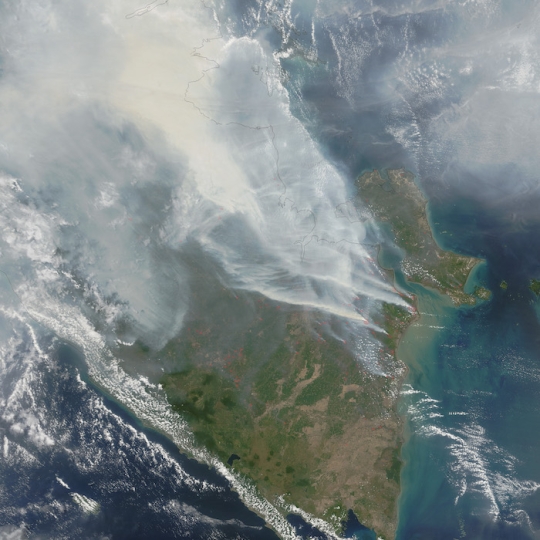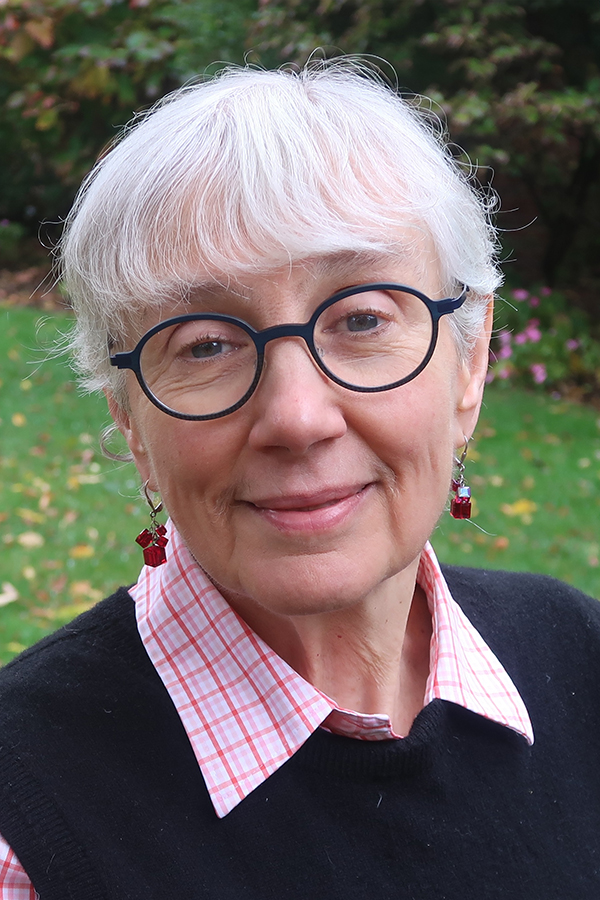News
Smoke from agricultural fires over Borneo in the fall of 2015. (Image courtesy of NASA Earth Observatory)
In the fall of 2015, hazardous levels of smoke from agricultural fires blanketed much of Equatorial Asia. Schools and businesses closed, planes were grounded and tens of thousands sought medical treatment for respiratory illness.
In a new study, Harvard University researchers and their colleagues estimate that the 2015 smoke event caused upwards of 100,000 deaths across Indonesia, Malaysia, and Singapore.
To mitigate the impact of future smoke events, the team developed a model framework which could help governments and policymakers in Southeast Asia identify, in almost real time, the fires with the highest potential to cause damage to human health.
The research is described in Environmental Research Letters. It was led by researchers from the Harvard John A. Paulson School of Engineering and Applied Sciences (SEAS), the Department of Earth and Planetary Sciences, and the T.H. Chan School of Public Health, in collaboration with colleagues from Columbia University.
“Although the regions experienced several major haze events over the past twenty years, the 2015 event was one of the worst,” said Shannon N. Koplitz, first author and Harvard graduate student. “We understand many of the underlying conditions that lead to these extreme events, and we can often predict when smoke pollution will be severe based on particular meteorological indicators, but regional efforts to mitigate the effects on public health have not been successful.”
“Our hope is that this framework can inform early-response efforts to identify areas where effective fire and land use management would yield the greatest benefits to human health, even as the haze event is still unfolding,” said Loretta J. Mickley, Senior Research Fellow at SEAS and coauthor.
The research is part of a larger effort by Harvard and Columbia to provide local stakeholders with an effective tool to assess the public health costs from fires and guide policy decisions. The framework uses a mathematical model to quickly identify the fires that will have the biggest impact on human health downwind.
“Decisions on how to manage the lands, which geographies to protect, how industries are regulated and where fires are allowed to burn are decisions of life and death,” said Samuel Myers, Senior Research Scientist at the T.H. Chan School of Public Health, Director of the Planetary Health Alliance and coauthor of the paper. “We want to support local policy makers to make those decisions with clear data.”
Fires started by farmers in Indonesia, particularly those producing palm oil and timber for wood pulp and paper, are the main culprits of haze events in this region. The fires, largely in coastal peatlands, burn at relatively low temperatures and can smolder for weeks or even months before extinguishing, resulting in lots of smoke.
During periods of extreme dry weather caused by El Niño and a phenomenon called the positive Indian Ocean Dipole, smoke emissions are considerably higher — either because farmers are taking advantage of the dry weather to burn more land or because once burning, the fires are more difficult to control. Although many fires burn in remote areas of Indonesia, prevailing winds can carry the smoke hundreds of miles to densely populated cities like Palembang in Sumatra, and Singapore and Kuala Lumpur.
The region experienced similar smoke conditions caused by El Niño in 2006 but the Harvard-led team found that deaths from air pollution more than doubled between the 2006 and 2015 events, from about 38,000 to about 100,000. This is largely because of where the fires burned in relation to population centers, and their intensity. Fires in southern Sumatra and nearby Jambi province turn out to be particularly deadly.
“Based on years of epidemiological research, we understand very well the relationship between pollution and mortality,” said Jonathan Buonocore, coauthor and research associate at the T.H. Chan School of Public Health. “We know for each incremental increase in air pollution, you get a certain incremental increase in mortality risk.”
Being able to identify the most dangerous fires could help save lives in the future, Buonocore said. “For the first time in Indonesia, we have a rapid assessment modeling tool that can quickly estimate the cost to human health of these haze events, as they are happening,” he said.
In ongoing work, the researchers are using the model to diagnose the health impacts of different land-use scenarios over the next 20-30 years. This effort could promote more rational land-use decisions and management that could save thousands of lives.
“If regional policy makers understand fully the health dimension of these biomass fires, we believe they will be in a better position to manage them more effectively and improve human health and ecosystems at the same time,” said Ruth DeFries, of Columbia University and coauthor of the paper.
This research was funded by the Rockefeller Foundation.
Topics: Environment
Cutting-edge science delivered direct to your inbox.
Join the Harvard SEAS mailing list.
Scientist Profiles
Loretta J. Mickley
Senior Research Fellow in Chemistry-Climate Interactions
Press Contact
Leah Burrows | 617-496-1351 | lburrows@seas.harvard.edu




